|
|
Perth

|
|
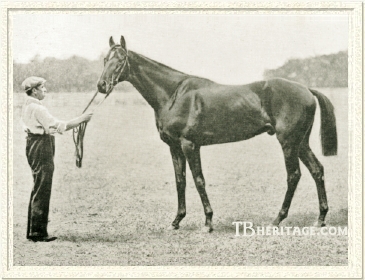 |
|
|
The elegant bay Perth was the only horse to win the four big three-year-old races in France, and was later leading sire in France three times. He was the Galopin sire line representative in France, extending that stallion's presence in France and Italy through several generations of good sire sons. Two of his daughters produced sire sons that spread his influence world-wide, and others sent him to the top of the leading broodmare sires list twice.
His sire, War Dance (1887), was a son of Galliard, the latter one of Galopin's best sons, winner of the Two Thousand Guineas, and the St. James's Palace Stakes and Prince of Wales's Stakes at Ascot. Galliard got some good runners, including Seemarchen, a winner of the Preis der Diana in Germany, and proved to be an excellent broodmare sire. His daughters included Black Duchess, the dam of Bay Ronald; Dame Masham, the dam of Fairy Gold (Woodcote Stakes winner and dam of Fair Play, Friar Rock and other good ones); Miss Hoyden, dam of Eclipse Stakes winner Lally; Philae, dam of the good French runner Punta Gorda, and Quayside, dam of the stayer Quérido (winner of Prix Jean Prat, Prix Noailles, Grand Prix Saint Cloud, and in England the Chester Cup). War Dance, out of War Paint, by Uncas, was bred by the British bookmaker Robinson, and purchased for a small sum -- 1,150 francs -- as a yearling at Robinson's dispersal sale by French banker Maurice Ephrussi.
Ephrussi (1849-1916) was a member of a family of Jewish bankers from Odessa, Russia, that established banks in Vienna, Austria and Paris. Part of Ephrussi's duties as a banker in Paris was his involvement with the Rothschild families' oil business in what is now Azerbaijan, and in 1883 Maurice married Béatrice de Rothschild, a daughter of banker Alphonse James de Rothschild. Ephrussi was an enthusiastic sportsman and successfully raced many horses, including a number of War Dance's offspring. His stud farm, Haras du Gazon, in Normandy, was later purchased by American Herman Duryea, where Duryea bred English Two Thousand Guineas winner Sweeper, Epsom Derby winner Durbar, the good U.S. runner Flambette, later an important broodmare in that country, and many others; the great mare Frizette was a broodmare at Duryea's Haras du Gazon.
War Dance ran for three years, and in 26 starts, over distances between 900 meters (as a juvenile) and 2500 meters, was unplaced only once. He was not entered in the classics, but did very well in some good races. As a juvenile he won the Prix du Poitou (Saint Ouen, 1100 meters) Prix de Maintenon (Maisons Laffitte, 1200 meters) and Prix du Consolation at Vicennes from seven starts. At age three, his twelve wins included the Grand Prix de Bruxelles (1700 meters in Brussels), five races in succession -- the Prix de Bonniéres (Maisons Laffitte, dead heat at 2200 meters), Prix de Meautry (Deauville, 1000 meters), Prix de Chemin de Fer (Deauville, 1600 meters), Prix de Villepreux (2200 meters), and Prix de Septembre at Vicennes (2100 meters); he was second in the Prix d'Ispahan (2400 meters) and two other races that season. At age four, running only in the fall, he won all three of his races: the Prix d'Auges (Fontainebleau, 2200 meters), Prix Clocher (2200 meters) and Prix de la Loire (2500 meters). He was retired to stud at Haras du Gazon, where he remained until his death in 1905.
In addition to Perth, War Dance got a number of good runners, including Roxelane (1894, from Rose of York, by Speculum), who raced for Maurice Caillault, her breeder, along with his partner Paul de Pourtalès. She was an unbeaten winner at two, including the Grand Critérium, and at age three won the Poule d'Essai des Pouliches and the Prix de Diane, and was second in the Grand Prix de Paris. She also won the Prix la Rochette. Roxelane is prominent in the annals of thoroughbred breeding through her son, the grey Roi Herode, who re-established the Herod sire line in Great Britain, primarily through his son, The Tetrarch.
Other War Dance offspring included Avallon (1895, from Avarice, by the Miser), winner of four races; Champ d'Or (1902, out of Eighteen Carat, by Saraband), bred and raced by Ephrussi, and winner of the Zukunfts-Rennen in Germany; Lady Killer (1898, from Lady Mayoress, by Lord Clive), winner of the Prix Monarque (now Eugène Adam) for James Hennessy and later a useful sire; Mordant (1904, from Magdala, by The Bard), winner of the Grand Critérium as a juvenile and the Prix du Jockey Club for his owner-breeder, Ephrussi; Saint Armel (1898, from Sublime by Sterling), winner of the Prix Hocquart and Prix la Rochette; La Chine (1900, from Flying Column by Chippendale -- a half-sister to Epsom Derby winner Sir Hugo), winner of the Furstenberg Rennen in Germany; Perm (1900, from Peroaison by Gournay), winner of the Prix Robert Papin.
War Dance's son, St. Caprais (1896, out of Sarcelle, by Fontainebleau), was a good stallion in Italy, but his best sire son other than Perth was Rodilard (1895), brother to Roxelane: he won the Poule d'Essai des Poulains for Marice Caillault, and was sold as a stallion to the brothers Julio and Eugenio Brown who shipped him to their Haras Pirque in Santiago, one of the earliest important breeding farms in Chile. There he got Soblesky (winner of La Huasca and La Prueba), Green and White (winner of the Criadores, Pascua and By the Sea), Hasard (winner of del Estreno, El Ensayo and other important races, and later a good stallion), Sayonara (GP Vina de Mar and other classic races), Graciela (Polla de Potrancas, Vina del Mar, and St. Leger), and many other winners. Griselidis, the best filly of her generation, and Jimena, the dam of two classic winners, were offspring of his daughters.
War Dance's good broodmare daughters, in addition to Roxelane included Cyclopee (1896, out of the Blair Athol daughter Cyclopaedia), the dam of Prix la Rochette winner Cartolina; Perm, dam of Prix Greffulhe winner Patrick; Queenie (1904, from Quilda, by Gamin), who produced Prix de Diane winner Quenouille.
In 1894 Primrose Dame (1885), a nine year old mare by the grand stayer Barcaldine, and out of Lady Rosebery, was sent from England to the Deauville sales by her owner, Sir J. Blundell Maple. She was in foal to Galopin. Bred by Lady Stamford, she had had been an indifferent runner, winning Epsom's Rothampstead Stakes and a selling plate at Newmarket in four starts as a juvenile, and at age three another selling plate at Newmarket, and none of her three English-bred foals showed much promise; in 1895 her first foal, Primrose Knight (1890) would win the Forest Plate at Alexandra Park for Lily Langtry. Ephrussi picked her up for the equivalent of £700, but she lost the Galopin foal. Ephrussi bred her back to Galopin's grandson, War Dance, and in 1896 she dropped Perth at Ephrussi's stud farm, Haras du Gazon. Primrose Dame would have six more live foals, amidst a number of barren and slipped years, and died in 1912. One of her fillies, Primavera (1897, by Upas), was the dam of Priori (1922, by Brûleur), a great stayer that won the Prix de l'Arc de Triomphe, the Prix du Cadran, the Prix Royal-Oak, and other good races, and a daughter, Primavista, bred on. A number of good runners, stallions and broodmares descend from Primavera, including Sassafras, Last Tycoon, and I Say.
Perth was a small, elegant bay colt, "full of character." A year later he was one of the sales toppers at the Deauville yearling sale, purchased for 27,500 francs by Maurice Caillault. Caillault had formed a racing stable with the Comte Paul de Pourtalès in 1896, placing Richard Carter, Jr., in charge as head trainer. Carter, who had begun schooling horses for C.J. Lefevre, trained the great runners Roxelane, Chéri, and Quérido for Cauillault and de Pourtalès, and later, for August Belmont, trained Amoureux III and the good filly Qu'elle-est-Belle.
Perth on the Turf
Perth's juvenile season gave little hint of the talent he was to exhibit at age three, despite his beautiful action. He ran five times, failing to place twice at Deauville before winning two small races at Vincennes. He was out of the money in the big juvenile race, the Grand Critérium, won by his generational rival, Holocauste (by Le Sancy), and ended the season with a win in the Critérium International over 1,000 meters at Longchamp, receiving weight from Ivan IV and Franco-Russe.
At age three Perth emerged as the best of his year, exhibiting the undeniable sturdiness of his broodmare sire, Barcaldine. He won the Prix Hocquart (2500 meters), the Poule d'Essai des Poulains (1600 meters), Prix Daru (2100 meters), the Prix du Jockey Club (2400 meters, by half a length over Vélasquez, with Holocauste six lengths behind), the Grand Prix de Paris (3000 meters, beating Vélasquez -- Holocauste had been sent to England), and the Prix Royal-Oak (3,000 meters, Vélasquez again second). He lost once, at the end of the season, when he ran third in the Prix du Prince d'Orange, carrying gobs of weight, beaten by the good horse Fourire (winner of Prix Boîard, the Grand Prix de Deauville and other races) and the good mare Jeanne Brunette. Perth was the only horse to win the four most important races for three-year-olds in France: the Poule d'Essai, the Prix du Jockey Club, the Grand Prix de Paris, and the Prix Royal-Oak.
At age four Perth ran twice. In France he easily won the Prix du Cadran by ten lengths. Then he was taken to England to run in its premier distance race, the Ascot Gold Cup; he was fourth (it was won by Lily Langtry's Australian-bred stayer Merman), having injured himself seriously enough during the running to force his retirement from the turf.
Perth in the Stud
Perth spent his entire, relatively short, career as a stallion -- 1901 to 1908 -- at Caillault's Haras de Nonant-le-Pin. He died early, of a sudden "disease of the kidneys" at the age of twelve. His skeleton was preserved and is now stored at Haras du Pin.
He was a very successful sire in his eight years at stud in France, three times leading sire: 1907, 1908, and posthumously in 1911. Between 1904 and 1912 his colts and fillies, many of them small and elegant, like himself, won more than 4.2 million francs on the flat, and over 250,000 francs over jumps. He was well-supported by his owner's mares, and by those belonging to some of the leading breeders in France. He got classic winners, stayers, steeplechasers, good juveniles, and some sprinters, and a number were as versatile as he was on the turf. His best running offspring were sons Alcantara, Faucheur, and Northeast, and daughter Sauge Pourprée. Alcantara was his best sire son, champion sire twice, and through his daughters and sons is seen in many pedigrees today. Perth's son Faucheur got Nid d'Or, five-times leading sire in Chile.
Some of Perth's daughters became influential broodmares, notably La Buire, dam of the Prix du Jockey Club winner Belfonds, later a successful sire, and Eglantine, the dam of Cesarewitch champion Rose Prince, grandsire of three leading sires in France and the U.S.
|
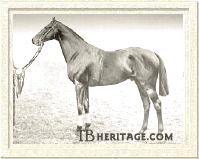
Alcantara
| |
ALCANTARA (1908) was a small, racy, high-strung bay with free action, out of Toison d'Or, a minor place-getter, by Le Sancy; Toison d'Or's dam, Harfleur, winner of the Nassau Stakes and Newmarket's October Handicap and several other races in England, was by Archiduc. In ALCANTARA'S second season on the turf he developed some seriously bad habits, including pulling, bearing out, and, on several occasions, attempting to savage his opponents. A change in strategy, which included blinkering and sending him to the front at the start of the race, where he could extend himself and not fret over other horses was successful, and led to his big six length victory in the Prix du Jockey Club; his ability to take and hold the lead was similar to that of his dam's sire, Le Sancy, and his great-grandsire, Archiduc.
|
Bred and raced by Baron Edouard de Rothschild, at age two he won three of his six starts -- including the the Prix Eclipse at Maisons-Laffite (1600 meters) and the Prix Heaume, and placed third once. He had difficulty at the start of his second season, unplaced in the Prix Delâtre (won by FAUCHEUR), third in the Prix Perplexite, second by 3/4 of a length to FAUCHEUR in the Prix Hocquart (2400 meters), and unplaced in the Poule d'Essai des Poulains (2,000 Guineas). When his quirks were dealt with, he won the Prix la Rochette (2200 meters), the Prix Lupin (2100 meters), and his crowning achievement, the Prix du Jockey Club (2400 meters). Unfortunately, his front-running style did him in the Grand Prix de Paris, where Michel Ephrussi's rabbit Granite, set a blistering pace, and Alcantara used himself up early and did not place, with the Macdonald II colt As d'Atout taking the race. After this, he won the Prix du Prince d'Orange at Longchamp (2400) meters, and was second to Combourg in the Prix Royal-Oak (3100 meters) and to Gavarnil in the Prix Eugene Adam (2000 meters, high weight), and failed to place in the Prix du Conseil Municipal and the Prix Edgard Gillois, heavily weighted in both. Early in 1912 he broke down and was retired to stud.
He got some winners, notably the great Rothschild filly Flowershop (1917) and some modest sire sons early in his career, and in 1920, largely due to Flowershop, was at the top of the French sires list. He was purchased by French sportsman Jean Stern (a Rothschild relative by marriage), just after World War I, and reached the top of the sires list again in 1928, and topped the broodmare sires list in 1932 and 1933. Located at the Haras du Mesnil stud of Jean and Elizabeth Couterié, he got many winning sons, daughters, and grandchildren for Stern. His temperament, never the best, gradually worsened over the years, and Stern, fearing his viciousness would incur an accident, had him shot in March of 1930, age 22.
ALCANTARA sired three winners of the Prix de Diane (Aquatinte, Flowershop, Gaba Tepe); one winner of the Poule d'Essai des Pouliches (Flowershop), one winner of the Poule d'Essai des Poulains (Indus); one winner of the Grand Prix de Paris (Kefalin), three winners of the Grand Critérium (Kantar, Kefalin, Indus), a winner of the 1,000 Guineas in England (Kandy), and the champion juvenile colt in France, Kantar (brother to Kandy), that later won the Prix de l'Arc de Triomphe. He had numerous other winners of races at 2200 meters and beyond. His son Pinceau (1925), winner of the Prix la Rochette and Prix de Chantilly, led the sires list in 1943, and got Verso, a superior winner of the Prix du Jockey Club, the Prix d l'Arc de Triomphe and later a successful sire in Italy and dam's sire of Le Fabuleux. Alcantara's champion son Kantar (1925), undefeated as a juvenile, was sire of the stayer and sire Victrix that was later dam's sire of Right Royal, Balto, and champion Neptunus; Kantar was also dam's sire of Caravelle and Klarion. Another Alcantara son, Indus (1928), was broodmare sire of French champion Tantieme.
As a broodmare sire Alcantara was responsible for Brumeux, Thor, Fastnet, Sif, and Tifinar, among many other good winners in France, England, Germany, and South Africa.
|
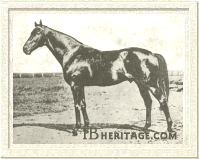
Faucheur
| |
The brown colt FAUCHEUR (1908), a generational rival of Alcantara's, was out of Fourragere, by the Perplexe son Palais Royal. He won three races for his owner, Baron Maurice de Rothschild, as a juvenile, including the most important race for two-year-olds, the Grand Critèrium. Big things were expected of him during his three-year-old season, and he did well enough early in the year, winning the Prix de Saint Cloud by a neck over indifferent opponents; taking the Prix Delâtre by a head, again without a high quality field; beating Coburg and some other good ones in the Prix Lagrange; and beating ALCANTARA by 3/4 of a length in the Prix Hocquart. Then disaster struck, when he bowed a tendon.
|
FAUCHEUR was sent to Rheims for rehab, where he swam daily for half an hour in a specially designed pool, and then exercised on the longe and at the trot for an hour daily to strengthen his leg, in an attempt to keep him in the running for the Prix du Jockey Club. He did run in the race (won by ALCANTARA), but he did not place, and his tendon did not hold up to the strain. He was retired from the turf, and sold for the huge price of 400,000 francs to a French breeding syndicate.
He was a moderately successful stallion, although he got nothing that justified his cost. His best was Nid d'Or (1922), winner of four races, including the Prix Ganay and the Prix du Conseil Municipal (2400 meters). Nid d'Or stood at stud in France for two years before his sale to Haras Cunaco in Chile, where he was leading sire five times in the late 1930s and early '40s. Nid d'Or's winners included Brown King (winner of El Derby and Chilean St. Leger) and Maraton (El Derby), and Wellington, a winner of a number of top races in Chile (including La Pureba, St. Leger), and a grand stayer; unfortunately, Wellington died after two years at stud, but he did leave some good runners from his first two crops.
Other FAUCHEUR offspring included La Chiffa (Prix de la Rochette); Canape (Prix Eugène Adam and Prix Miss Gladiator); Rovigo (seven wins, including Prix Ganay and Grand Prix de la Ville de Vichy); Cabire (Prix Jean Prat), and Concorde (Prix de Flore, Autumn Cup), the dam of Paix des Dames (Prix Henry Delamarre and other good races).
|
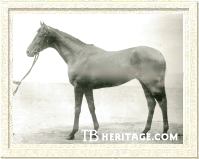
Northeast
| |
NORTHEAST (1905) was another of Perth's good mid-distance runners, a horse with a notable turn of speed, that ran also well at distances between 1,000 and 3,400 meters. He was raced by American W. K. Vanderbilt, who had successful racing stable in France, and was out of the Le Hardy mare Nordenfield. Le Hardy won the Poule d'Essai des Poulains and the Prix Dollar, placed second in the Prix du Jockey Club, and was a moderately successful sire in France. Nordenfield's dam, Stockholm, was an excellent race mare, winner of the Poule d'Essai des Pouliches, the Prix Royal Oak, and in England, the Goodwood Stakes.
|
NORTHEAST (1905) won the Prix de Villers (1,000 meters) and the Prix de la Tocques at Deauville in his first two outings at age two. At Chantilly, giving away five pounds, he was third in the Critérium, just 3/4 of a length behind the winners (won by a neck by Perth's daughter SAUGE POURPRÉE), second in the Grand Critérium d'Oestende to SAUGE POURPRÉE, and finished the season winning the Critérium de Maisons-Laffitte (1200 meters).
At age three he ran unplaced in the Prix de Saint Cloud, he was a close third in the Prix Delâtre (Maisons, 2000 meters), and then ran second to Conquistador in the Prix des Cars, with a good field that included Grill Room, MAGELLAN and Lincoln behind. In the Poule d'Essai des Poulains he was second to Monitor, after which he won three successive races: Prix de la Malmaison (Saint Cloud, 2,000 meters), Prix d'Herbeville (Saint Cloud, 2,000 meters), and Prix Stockwell (Tremblay, 2,000 meters). Next up was the Prix du Jockey Club; his stablemate, Sea Sick, was favored by Vanderbilt to win, and Northeast ran third, held in check by his jockey, when Sea Sick dead-heated with Quintette. His next race was the Prix Mackenzie-Grieves at Longchamp (2400 meters), which he won. In the Grand Prix de Paris he went off at odds of 9:1, with several horses, included Quintette, SAUGE POURPRÉE, and other good winners slightly better favored in the 18 horse field. He won the race by 3/4 of a length in the record time of 3:14-2/5. Sea Sick was back up against him in the Prix du Président de la République at Maisons, and Northeast was sacrificed for Sea Sick's win. In his last race that season, the Handicap de Longchamp at Deauville, over 3400 meters, he was 3/4 of a length behind the winner SAUGE POURPRÉE.
At age four NORTHEAST ran once, in the Prix de Palaiseau over 2,000 meters, winning in a canter. He was then purchased by Mrs. Lemaire de Villers who, the year before, had purchased the Haras du Becquet, Saint-Paul at Oise, an estate previously owned by Prince Soltykoff. In 1910 Northeast was retired, sound, to serve as the premier stallion at her new establishment. He died early, in 1913, and although his few crops of youngsters sold for good prices at Deauville (his daughter Sainte-Alliance, from Mario, was sold for 50,000 francs at the yearling sale in 1912) he left little of note.
|
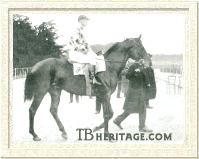
Diadoque
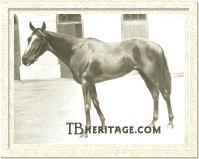
Hag to Hag
| |
DIADOQUE (1905) was out of Dauphine, and bred by Caillault. Running for his breeder, he was second in his debut, the Prix des Genets at Saint Cloud, and placed three more times in his first season. When Cauillault's stable was dispersed, a Mr. Bally purchased him for 11,000 francs, but at age three he won just one small race, the Prix Aloès (Tremblay) in ten starts. He was then sent over fences, and at age four he won eight races in 22 starts over obstacles, including seven consecutive wins, among them the Prix des Cévennes, the Prix Blaviette (both at Enghien), the Prix Fragoletto (Sain-Ouen), the Prix des Pau, Prix de Chambly, Prix de Montretout, and the Prix de Condé, all at Auteuil.
HAG TO HAG (1906) was a small bay colt out of the Australian-bred mare Haulette (Family C - 3), winner of the AJC Champagne Stakes as a juvenile, and the VRC Oaks Stakes at age three. French distillery baron James Hennessy selected Haulette for his stud and brought her to France in 1904. HAG TO HAG was raced by his breeder, and won two races as a juvenile, including the Prix la Rochette. At age three he won the Grand Prix de Bruxelles and, unexpectedly, the Prix du Conseil Municipal, and placed third in the Prix Miss Gladiator, the Prix Mackenzie-Grieves, and the Furstenberg Memorial at Baden Baden. In the stud he was a useful sire of jumpers.
|
| Perth's son GO TO BED (1903, from Mademoiselle Chiffon, by Krakatoa), bred by Mme. Henri Say, was primarily a sprinter, raced first by J. Le Gonidec, and then by the duc de Decazes. He won over 81,000 francs between the ages of three and five; his wins included the Prix d'Auteuil, the Prix Compiégne, the Prix du Gros-Chêne, the Prix Perplexe, and the Prix de Bally. His son, Baldaquin, ran second to Dagor in the Prix du Jockey Club, beating the good runner Brûleur (later winner of the Grand Prix de Paris). His daughter, Prude (1910), bred by the Comte Foy, won some minor races at ages two and three, and at age four placed second in the Prix de Fille de l'Air. She became the dam of Pitchoury (1922), a 92,000 francs yearling by Cannobie. He won the Deuxième Critérium (1000 meters) at Chantilly and the Prix de la Touques (1200 meters) at Deauville as a juvenile, and at age three won the Grand Prix du Printemps and was second in the Prix du Jockey Club to his relative, Belfonds.
|
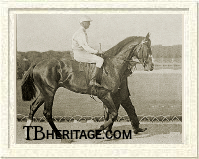
Magellan
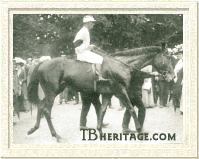
Ramesseum
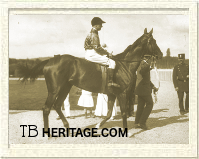
Sauge Pourpree
| |
Other Perth sons won a number of good races in France, Belgium and Germany. BORAX (1902, out of Belle of Hampton, by Hampton), won the Prix Edgard de la Charme; KALISZ (1904, from the Atlantic daughter Kara Belnaia) won the Prix Greffulhe (2100 meters) at age three, and the 4200 meter Prix du Cadran at age four for his owner-breeder Cauillault. MABOUL (1907, from Mad, by Le Sancy) won the Furstenburg Rennen, among other races, and was later a sire in France, and then Brazil; MATTERHORN (1909, from Myakka, by Sensation), won the Union-Rennen in Germany. MAGELLAN (1905, from Pietra Mala by Atlantic) won the Prix Monarque (later Prix Eugène-Adam) and the Grand Prix d'Ostende, among other races.
RAMESSEUM (1907), bred by Paul de Pourtalès at Haras de la Rablais, won the Prix le Sagittaire as a juvenile for W.K. Vanderbilt, who bought him for 28,000 francs as a yearling.
MY PET (1904, from My Mary, by Ayrshire), was bred at Hars de Lormoy, the stud of sugar magnat Henri Say, who had imported the leading stallion The Bard. My Pet was purchased as a yearling by Sol Joel, who took him to England. There he won Epsom's Dewhurst Stakes, the Hopeful Stakes at Newmarket, Goodwood's Molcomb Stakes, and three other races from eight starts at age two, but he failed to successfully train on.
Perth got only one really successful racing daughter, SAUGE POURPRÉE (1905), a brilliant juvenile, classic winner, and later a top handicap mare that beat some of the best horses of her day. Out of the Chalet daughter Medeola, and raced the Comte Le Marois, she was finally retired at age four, after contesting several races where she was so heavily weighted her owner withdrew her, rather than have her run on such unequal terms. Unfortunately, she was not a particularly successful broodmare; a son, Le Dragon (1914, by her old rival Sea Sick), became a stallion in Yugoslavia after being at stud in France, and one of his daughters, Grey Duchess, sent to the U.S., became the dam of some winners, including Louisiana Derby winner Grey Count. A daughter, Gloire de Lorraine, was second dam of Marche Lorraine, winner of the Prix Cleopatre and the Prix de Saint-James and later a dam of winners in the U.S.
|
SAUGE POURPRÉE was the top juvenile of her generation, winning the Grand Critérium d'Oestende, the Zukunfts-Rennen at Baden Baden, the Omnium de Deux Ans (Prix Robert Papin), the Prix de l'Avenir, and the big one, the Grand Critérium at Chantilly, and she was second to Valda in the Prix de la Forêt.
At age three she easily won Le Prix Citronelle and the Poule d'Essai des Pouliches, but was beaten into second place in the Prix de Diane by Médéah. She then ran second to Perth's son NORTHEAST in the Grand Prix de Paris. She did not place in the Prix Monarque, but in the Prix de Longchamp, at Deauville, she beat NORTHEAST, and in the Prix de Flore she trounced Médéah. In her next race, the Prix Vermeille, she and Médéah switched placings. In the distance race the Prix du Conseil Municipal, she carried the heaviest weight, and did not place. The Prix Edgard Gillois was an easy win for her. She also won the Prix de Deauville (3,000 meters, now Prix Kergolay).
At age four she started by winning Le Biennal (now Prix Jean Prat) by ten lengths, beating Val Suzon, and then won the big distance races for older horses, the Prix Du Cadran (4200 meters). She was third in the Prix Edgard Gillois, beaten by Sea Sick and Gigolo II, and heavily weighted in the Prix La Rochette, she barely beat the much inferior Val Suzon, which she had bested by ten lengths earlier in the season. After this the Count decided to retire the sturdy, game mare.
None of Perth's other fillies were winners of big races, although he had many that ran in or won small regional races. Two of his daughters produced influential sire sons -- Rose Prince and Belfonds -- but otherwise his role as dam's sire of winners was not particularly impressive.
EGLANTINE (1906, out of dual classic winner Rose de Mai, by Callistrate) was the dam of Rose Prince and two daughters that bred on, with Irish classic winners numbering among their descendants. Rose Prince, winner of the Cesarewitch and other races, got Belgian race winner Prince Rose, whose sons included Prince Chevalier (leading sire in France), Princequillo (twice leading sire in the U.S.), and Prince Bio (leading sire in France).
LA BUIRE (1907), out of the Enthusiast mare, Lark, was bred by Ephrussi and sold to Madame Cheremeteff; she did not place on the flat at ages two and three. Sold to the amateur rider Comte Couret de Villeneuve, at age four she was sent over fences, winning two small races, the Prix de la Reine-Jeanne à Evreux (ridden by de Villeneuve) and the Prix Foulques-Nerra at Durtal. LA BUIRE became the dam of grey colt Belfonds (1922, by Isard II), the best of his year at age three, winner of four races, including the Prix Hocquart, the Prix Greffulhe, and the Prix du Jockey Club for his owner, Argentinian Edouard Martinez de Hoz. In France he got some good daughters, notably four winners of the Prix de Diane -- Commanderie, Vendange, Peniche, and Lysistrata -- and Ligne de Fond, winner of the Poule d'Essai des Poulains. Commanderie was a great race mare, and also won the Grand Prix de Paris, beating the top colts of her year. Also in France Belfonds was dam's sire of the high-class winner Antonym, and 1940 Epsom Derby winner Pont l'Eveque. Belfonds was imported into Virginia by a syndicate headed by A.S. Hewitt in 1937, to replace Hewitt's French-bred stallion, Ksar; he died in 1942.
SARABANDE (1902, from the Le Sancy daughter Souris) was the dam of Sarrasin (1909), a winner of the Furstenberg-Rennen. MELOPEE (1906, out of the good race mare Mirelle, by Vesuvian), produced Mont Renaud (1918), winner of the Prix Miss Gladiator. The in-bred PHILANOE (1909, a half-sister to the good runner Punta Gorda, out of Philae, by Galliard) produced Samic (1918, by Bayardo), a winner of the Prix Penelope, that bred on with good winners in France and the U.S. among her descendants. PHILANOE'S full brother by Perth, POOR BOY (1905), ran in England, and won ten races. TARNKAPPE (1908, from the Le Sancy daughter M.T.), produced Taucher (1913), a winner of the Henckel-Rennen and the Union-Rennen in Germany. SARDONISE (1906, from Le Sancy's daughter Sardoine) bred on; she was second dam of the filly Stearine (1916), winner of the Prix Royal-Oak, and a number of good winners to the present descend from her.
Perth was a versatile winner of the most important races in France, and easily extended to win at a distance. As a stallion he was extremely successful, getting sons that were top juveniles, classic winners, and distance horses, and some offspring that did well over fences. A grandson of Galliard in tail male, he continued the Galopin sire line in France, extending through his good son Alcantara to the Prix du Jockey Club winner Verso, the last successful male line descendant of this branch. We see Perth in pedigrees today through his daughters and the daughters of his sons and grandsons.
--Patricia Erigero, with special assistance from Tim Cox
|
|
|
|

